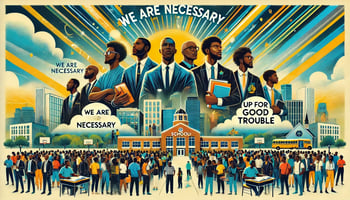As a Black, queer man, and an educator, my journey has been anything but straightforward....
The Educator's Guide to Work-Life Harmony: Strategies for Self-Care
In the serene ambiance of my favorite nook, surrounded by the comforting aroma of tea and the soft glow of incense, I found myself deeply immersed in a conversation that would reshape my approach to education and well-being. On a recent episode of The Minimalist Educator Podcast, where I had the pleasure of sharing my journey, we delved into "Wellness Strategies for the Thoughtful Educator." As I reflect on our dialogue, I'm compelled to share not just the insights but also the tangible resources that have illuminated my path to integrating wellness into the fabric of educational practice.
 Embracing the Unsung Hero Within
Embracing the Unsung Hero Within
As educators, we tirelessly pour our hearts and souls beyond the classroom walls, often forgetting the toll it takes on our well-being. My journey has taught me the paramount importance of acknowledging this dedication and nurturing our own wellness to truly inspire and uplift those around us.
The Power of Empathetic Leadership
One of the profound realizations from our conversation was the synergy between empathetic leadership and teacher well-being. I've learned that by fostering an environment where mindful breaks and open dialogues about work-life balance are celebrated, we not only enhance our well-being but also set a powerful example for our students and colleagues.
To embody this principle, I've turned to resources like Headspace for Educators, which offers free access to guided meditations and mindfulness exercises, creating moments of tranquility amidst the hustle of our daily routines.
Drawing Wisdom from the Depths of Mindfulness
Our discussion paid homage to the insights from "The Body Keeps the Score," highlighting the undeniable impact of mental and physical downtime. This wisdom has been a guiding light, reminding me of the delicate balance between our professional zeal and the necessity for rejuvenation.
Integrating mindfulness into the classroom has been a transformative experience, not just for me but for my students as well. Platforms like GoNoodle have become an integral part of our routine, offering movement and mindfulness videos that enrich our classroom experience with joy and serenity.
The Journey of Minimalism and Self-Improvement
As our enriching dialogue drew to a close, the call to embrace minimalism and embark on a personal journey of self-improvement resonated deeply. This philosophy has encouraged me to adopt a minimalist approach in my life and teaching, focusing on what truly matters.
In this spirit, I've explored Mental Health First Aid, a remarkable clearinghouse of tools, resources, and insights that have equipped me with strategies to enhance my happiness and cultivate productive habits, both in my personal life and professional practice.
My Toolkit for Transformation
Throughout this journey, I've leaned on a plethora of digital resources to weave wellness into my daily life and teaching:
- Calm and Headspace have been my sanctuaries for mindfulness and meditation, offering a respite from the day's challenges.
- Yoga Ed. has provided me with the tools to integrate yoga into our classroom, promoting physical well-being alongside mental calm.
- For creative and emotional expression, Canva for Education has allowed both me and my students to design visuals that reflect our mindfulness journey.
- Kahoot! has added an element of fun and engagement, enabling us to explore wellness concepts through interactive games.
Reflecting on the Path Unfolded
As I share these reflections and resources, I hope that they serve as beacons for fellow educators on their journey to wellness. The path is both personal and shared, a tapestry of individual experiences woven into the collective narrative of our educational communities. Let us embark on this journey together, embracing the minimalism of focusing on what truly enriches our lives and the lives of those we touch through our teaching




